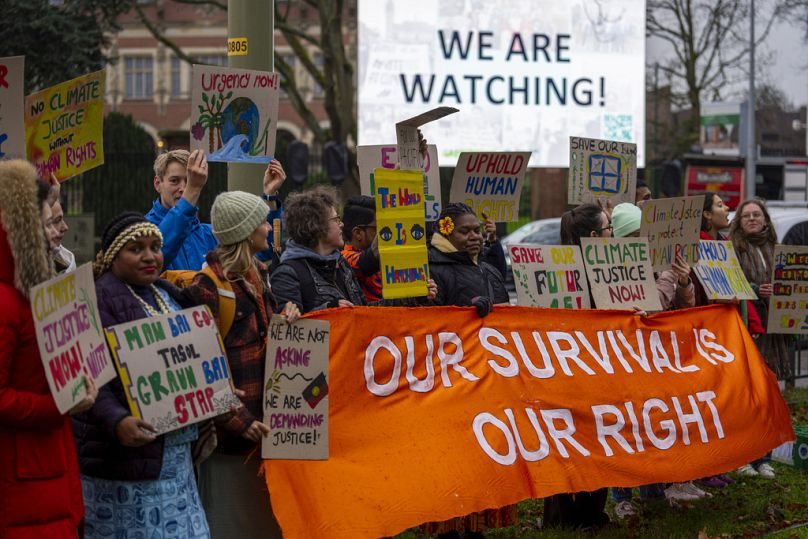Can ICJ’s landmark ruling save Small Island Developing States (SIDS) from climate catastrophe? – Down To Earth

Report on the International Court of Justice Ruling on Climate Change and its Implications for Sustainable Development Goals
1.0 Executive Summary
On July 23, 2025, the International Court of Justice (ICJ) in The Hague delivered a landmark ruling concerning the obligations of states in relation to climate change. This ruling was initiated by a global coalition led by Vanuatu, representing a total of 57 Small Island Developing States (SIDS). The decision marks a significant moment for international environmental law and has profound implications for the achievement of the United Nations Sustainable Development Goals (SDGs), particularly for nations facing existential threats from climate impacts.
2.0 Background: A Coalition for Climate Justice
The legal action was spearheaded by SIDS, a group of nations disproportionately affected by the adverse effects of climate change despite contributing minimally to global greenhouse gas emissions. This initiative represents a critical activation of international legal frameworks to address climate inaction.
- SDG 17: Partnerships for the Goals: The coalition of 57 nations exemplifies a powerful partnership, uniting to leverage international law for the collective good and to hold more developed nations accountable for their climate commitments.
- SDG 16: Peace, Justice and Strong Institutions: By seeking an advisory opinion from the ICJ, the SIDS coalition utilized a key international institution to clarify legal obligations, reinforcing the role of justice and global governance in addressing the climate crisis.
3.0 Significance of the Ruling for Key Sustainable Development Goals
The ICJ’s ruling provides critical legal clarity that directly supports the implementation of several SDGs. The primary focus is on establishing the legal consequences for states failing to take sufficient action to mitigate climate change.
- SDG 13: Climate Action: The ruling is a monumental step in enforcing climate action. It clarifies the legal duties of states to protect the climate system, thereby strengthening the foundation for more ambitious national and international climate policies and holding states accountable for their commitments under international agreements.
- SDG 14: Life Below Water & SDG 15: Life on Land: For SIDS, the health of marine and terrestrial ecosystems is paramount. The ruling reinforces the obligation of states to prevent transboundary harm, which includes damage to coral reefs from ocean acidification and the degradation of coastal ecosystems from sea-level rise, directly supporting the conservation targets of SDG 14 and SDG 15.
- SDG 11: Sustainable Cities and Communities: The existential threat to communities in SIDS from rising sea levels and extreme weather events is a core concern. The ruling underscores the responsibility of states to protect the rights of vulnerable populations, including their right to housing and security, which is central to achieving sustainable and resilient communities.
- SDG 1: No Poverty & SDG 8: Decent Work and Economic Growth: Climate change threatens to reverse development gains and exacerbate poverty in SIDS by devastating key economic sectors like tourism and fisheries. By compelling stronger climate action, the ruling indirectly works to protect the economic foundations of these nations, contributing to the objectives of SDG 1 and SDG 8.
4.0 Conclusion
The ICJ’s ruling on climate change is more than a legal interpretation; it is a foundational pillar for accelerating the 2030 Agenda for Sustainable Development. It validates the efforts of the world’s most vulnerable nations to seek justice through established international institutions and reinforces the interconnected nature of climate action with broader goals of poverty eradication, environmental protection, and sustainable economic development. This decision serves as a critical catalyst for ensuring that global climate policy is aligned with principles of equity and international law, thereby advancing a sustainable future for all.
1. Which SDGs are addressed or connected to the issues highlighted in the article?
Explanation of Identified SDGs
- SDG 13: Climate Action: The article’s central theme is the “existential threat” of climate change to Small Island Developing States (SIDS) and the “landmark ruling by the International Court of Justice (ICJ) on Climate Change.” This directly addresses the urgent need to combat climate change and its impacts.
- SDG 16: Peace, Justice and Strong Institutions: The article highlights the use of a major international legal body, the ICJ, to address the climate crisis. The initiative by Vanuatu and other nations to seek a legal ruling demonstrates an effort to leverage international justice systems to ensure accountability and promote the rule of law concerning climate obligations.
- SDG 17: Partnerships for the Goals: The article mentions a “global call” and a coalition of “57 member nations” (SIDS) acting together. This collective action to bring the issue to the ICJ exemplifies a partnership to achieve a common goal, which is central to SDG 17.
2. What specific targets under those SDGs can be identified based on the article’s content?
-
SDG 13: Climate Action
- Target 13.1: Strengthen resilience and adaptive capacity to climate-related hazards and natural disasters in all countries. The article’s statement that SIDS face an “existential threat” from climate change directly points to the critical need for enhanced resilience and adaptation, which this target aims to address.
- Target 13.b: Promote mechanisms for raising capacity for effective climate change-related planning and management in least developed countries and small island developing States. The article’s specific focus on the plight and actions of SIDS aligns perfectly with this target, which emphasizes building capacity in these particularly vulnerable nations.
-
SDG 16: Peace, Justice and Strong Institutions
- Target 16.3: Promote the rule of law at the national and international levels and ensure equal access to justice for all. The “landmark ruling by the International Court of Justice (ICJ)” is a direct application of international law to the climate crisis, embodying the promotion of the rule of law at the international level.
- Target 16.8: Widen and strengthen the participation of developing countries in the institutions of global governance. The initiative being led by Vanuatu and a coalition of 56 other SIDS nations to utilize the ICJ demonstrates their active and strengthened participation in a key institution of global governance.
-
SDG 17: Partnerships for the Goals
- Target 17.9: Enhance international support for implementing effective and targeted capacity-building in developing countries to support national plans to implement all the Sustainable Development Goals. The collective action of 57 SIDS nations represents a form of South-South cooperation and a “global call” to build capacity and implement plans for climate survival.
3. Are there any indicators mentioned or implied in the article that can be used to measure progress towards the identified targets?
Implied Indicators
- Indicator for Target 16.3 and 13.b: The “landmark ruling by the International Court of Justice (ICJ) on Climate Change” serves as a qualitative indicator. It signifies progress in using international legal institutions to establish clear obligations regarding climate change, which supports SIDS in their fight for climate justice.
- Indicator for Target 16.8 and 17.9: The number of countries involved in the initiative, “57 member nations,” is a quantitative indicator. It measures the extent of participation and partnership among developing countries in leveraging global institutions to address their specific vulnerabilities.
4. Create a table with three columns titled ‘SDGs, Targets and Indicators” to present the findings from analyzing the article.
| SDGs | Targets | Indicators (Implied from the article) |
|---|---|---|
| SDG 13: Climate Action |
13.1: Strengthen resilience and adaptive capacity to climate-related hazards.
13.b: Promote mechanisms for raising capacity for effective climate change-related planning and management in SIDS. |
The “existential threat” faced by SIDS highlights the urgency for resilience.
The focus on SIDS’ legal action as a mechanism for climate planning. |
| SDG 16: Peace, Justice and Strong Institutions |
16.3: Promote the rule of law at the international level.
16.8: Widen and strengthen the participation of developing countries in the institutions of global governance. |
The “landmark ruling by the International Court of Justice (ICJ)”.
The initiative led by a coalition of “57 member nations” (SIDS) at the ICJ. |
| SDG 17: Partnerships for the Goals | 17.9: Enhance international support for implementing effective and targeted capacity-building in developing countries. | The “global call” and collective action of 57 SIDS nations. |
Source: downtoearth.org.in

What is Your Reaction?
 Like
0
Like
0
 Dislike
0
Dislike
0
 Love
0
Love
0
 Funny
0
Funny
0
 Angry
0
Angry
0
 Sad
0
Sad
0
 Wow
0
Wow
0



























;Resize=805#)


















































